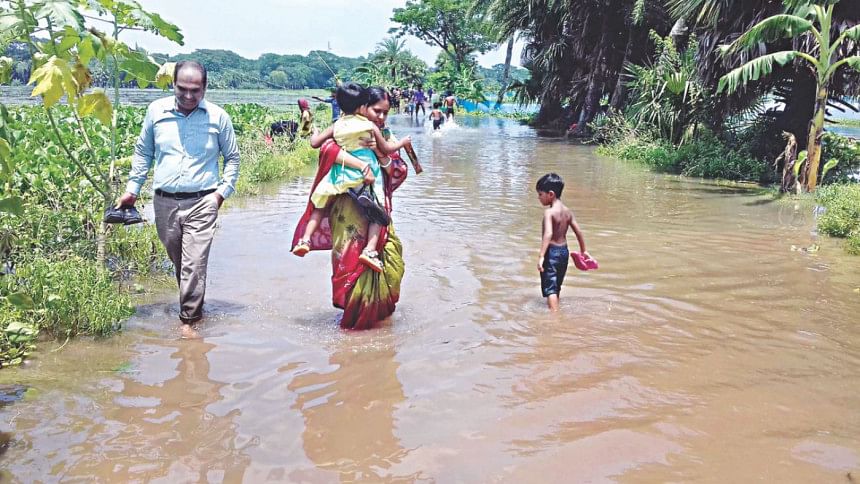Bhabadaha: A tale of sorrow

Once famed for the ingenuity of its 21 sluice gates designed to efficiently channel the water of several rivers through plains and wetlands, the Bhabadaha area in Jessore has in more recent times become a tale of sorrow. Several of the sluice gates have been inoperative for years, with siltation-aggravated, avoidable flooding the current hallmark of each monsoon. This year, heavy rainfall has caused havoc across the country. Bhabadaha has not fared well.
Across three upazilas of Jessore and two in Khulna, areas that should be able to rely on the Bhabadaha infrastructure, over 100 villages are currently inundated with several thousand homes damaged. Many schools are submerged. The flooding is primarily the result of the failure to manage water flows from the Muktershari, Teka, Bhadra, Shree and Hori rivers. In places the riverbeds are higher than the plains around them, with siltation leading to overflow.

“Riverbed siltation has been causing prolonged water-logging in the south-western part of Khulna division for around three decades,” says Ranjit Bawyali, convenor of the Bhabadaha Water Management Committee. “Despite our requests the government has not taken effective action.”
On a recent visit to the area, The Daily Star observed over two thousand people taking shelter on the road, together with their belongings, livestock and poultry. “I was forced to take shelter here along with my six cows, because my home is underwater,” says Tarapada Mondal, 72, from Dumurtala village in Jessore's Abhaynagar upazila. Usually a solvent farmer, he currently resides in a makeshift cottage on the Noyapara to Moshitati road.
“I am unaccustomed to living on the road,” says his wife Anarati Mondal, “so we have managed to rent two rooms in another roadside home for me, my son and my daughter. We will stay here as long as the flooding remains. We have no alternative.”
The stagnant water is itself a health hazard. Many latrines have overflowed and are unusable. Safe drinking water is scarce. “Twelve out of fourteen villages in our union are submerged,” says Bikash Roy, chairman of the Sundoli union council within Abhaynagar. “Drinking water is hard to find because many tube wells are underwater.”
Shakhor Chandra Roy, the council chairman of Kultia union in adjacent Manirampur upazila, also in Jessore, says that in his local government area all seventeen villages are submerged, with eight facing especially dire circumstances.
Built in the early 1960s by the then East Pakistan Water and Power Development Authority, the Bhabadaha infrastructure includes sluice gates, polders and embankments. It was designed to protect human settlements from tidal surge, cyclones, floods and the intrusion of saline water. But along with decayed and broken infrastructure, the illegal occupation of around six hundred acres of river lands by influential parties, who have established brickfields, fish enclosures and housing in areas critical to the river management scheme's success, has helped to cause the system's collapse.
“To address the problem, we have commenced excavation works in two phases at a cost of Tk 1 crore, covering eight kilometres from Chomordanga to Dayerkhal in Abhaynagar,” says Jessore's executive engineer with the Bangladesh Water Development Board, Probir Kumar Goshami. “The project, scheduled for completion on 30 August 2017, includes an obligation to clean garbage and lift silt from the sluice gates as well. But two out of the four excavators have been out of order for months; we have repeatedly asked the contractor, Sonny Corporation, to repair them as a matter of urgency.”

Locals too are unhappy with the work of Sonny Corporation, which they accuse of not excavating the river deeply enough and of dumping mud along the riverbank such that it will gradually filter back into the riverbed.
But the owner of Sonny Corporation, Habibur Rahman, told The Daily Star they are fulfilling their obligations as per schedule. “The water development board is monitoring our work,” he says, “so there is no opportunity not to do the job properly. It is true, though, that we are facing difficulty in repairing our two excavators.”
“We have taken many steps to discharge water through the rivers but it will take time,” says Shwapon Bhattacharya, a lawmaker from Jessore-5 constituency.
After several decades of 'time', many locals are unconvinced. “The government has no sympathy for us,” says Bikash Kabiraj, a disgruntled resident of Soradanga village in Monirampur. “We have suffered for years and the government hasn't done anything.”


 For all latest news, follow The Daily Star's Google News channel.
For all latest news, follow The Daily Star's Google News channel. 








Comments